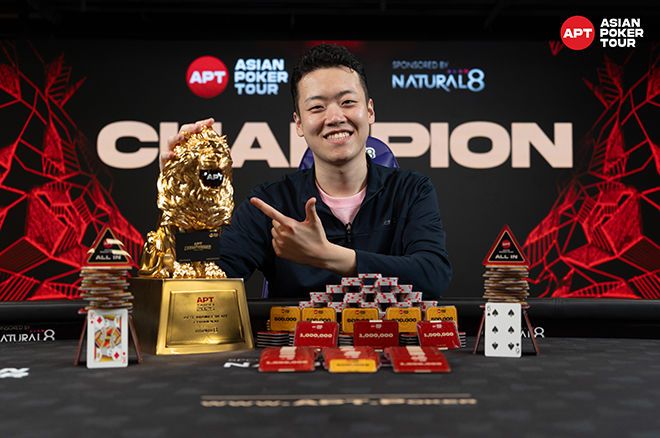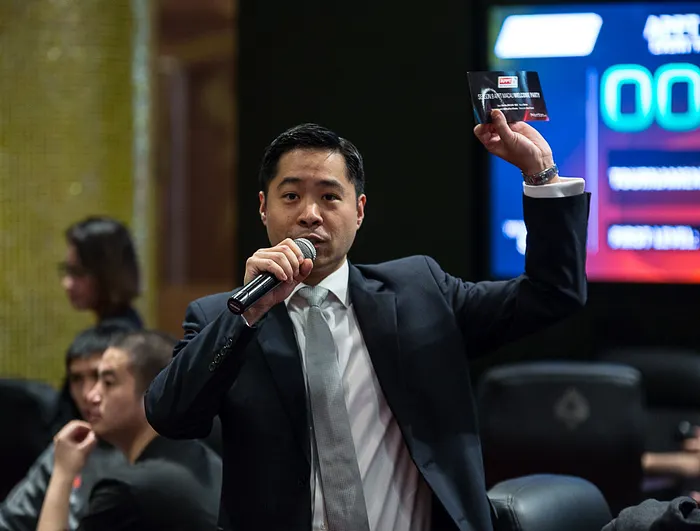Warning: Undefined array key "post_type_share_twitter_account" in /var/www/vhosts/casinonewsblogger.com/public_html/wp-content/themes/cryptocurrency/vslmd/share/share.php on line 24

Earlier this month, Abraham Ceesvin lifted the Asian Poker Tour (APT) Jeju Main Event trophy and collected a KRW649,835,200 ($461,177) prize. Ceesvin didn’t just help himself to a career-defining prize; he was standing on the stage of a rapidly growing poker tour rewriting the map for live poker in Asia.
The Jeju festival broke several attendance and prize pool records for the region. The flagship Main Event set a new all-time Korean record, drawing almost 1,700 entrants.
From Manila Beginnings to a Pan-Asian Fixture
The APT launched in 2008, with its first event in Manila. Since then, it has grown into a full festival tour that travels to Macau, the Philippines, South Korea, Taiwan, Vietnam, and beyond. The tour has expanded year-on-year, with each of its stops boasting dozens of tournaments with ever-growing attendances and soaring guarantees on those events’ prize pools.
A notable turning point in the APT’s fortunes came in 2022 when APT Events Private Limited bought the APT. The new owners had lofty ambitions of making the APT not only Asia’s premier poker tour but also a product renowned the world over.

Several changes were made to the APT’s management team, not least appointing Fred Leung as the company’s Chief Executive Officer (CEO). Leung, a former PokerStars Live executive, was integral in developing Asia’s biggest and richest poker events between 2008 and 2018, including the Asia Championship of Poker (ACOP), Macau Poker Cup, and Red Dragon.
Leung’s leadership and his team’s hard work and dedication behind the scenes had an immediate positive impact. Together, they instilled a new level of professionalism, partnerships with online poker sites (notably Natural8), widening the tour’s footprint and taking it to new destinations, and creating exciting, action-packed schedules that have something for everyone.
Everything has come together seamlessly, massively increasing the tour’s prestige. Players enjoy larger festivals, juicier prize pools, and an ever-increasing international mix of players.
The Numbers That Prove Momentum

If there was ever a year that showed how far the APT has come, 2025 was it. The recent Jeju festival set multiple records, including the largest international poker tournament ever held in Korea when 1,693 players turned out in force for the Main Event. Such a turnout made the APT Jeju Main Event the third-richest in the tour’s history.
The top two are also international record-breakers. The 2,350-entry APT Hanoi Billions 2023 Main Event and its hefty VND73,855,800,000 ($3,038,600) prize pool are the biggest tournaments ever to be held in Vietnam.
However, it is Taipei that currently holds the top spot as most successful in tour history, with the 2,547-strong APT Taipei 2025 Main Event and its massive TWD121,033,440 ($3,720,160) prize pool the largest and richest tournament ever to play out in Taiwan.
The Main Event’s multi-million-dollar prize pool demonstrated that Asia can host events rivalling those of Europe and the United States.
It’s not only the impressive guaranteed prize pools, but also the sheer number of tournaments each APT stop runs. The upcoming APT Championship, which runs November 14-30 in Taipei City, has over 200 tournaments, including satellites. Those tournaments include everything from affordable turbos to high-stakes action, and the APT Championship Main Event that boasts a USD 5 million guarantee on its prize pool!
What is the APT Doing Differently?

APT’s rise since the 2022 rebranding is no accident. The tour has developed a winning formula by blending festival-style scheduling with an inclusive, regional approach. Its events typically stretch over 10 days or more, mixing low buy-in tournaments, high-stakes showpieces, and side events catering to every player level.
Additionally, the days when APT schedules only featured No-Limit Hold’em tournaments with the occasional Pot-Limit Omaha event are long gone. APT players now get to battle it out across a wide range of poker variants, including but not limited to Triple Draw Mix, Omaha Hi-Lo, Seven Card Stud, Badugi, Five-card PLO, Big O, Eight Game, 10-Game Mix, Dealer’s Choice, and Razz. Each APT schedule is akin to a World Series of Poker (WSOP) in Las Vegas, allowing players to play events in a live setting that would ordinarily only be available online.
Localization has been another key to the APT’s success. Tournaments are run in local currencies, the tour offers multilingual support, and its schedules are designed to fit the habits and preferences of Asian players.
Furthermore, it’s evident that the APT adopts a player-first policy, ensuring their wants and needs are met at every stage of their journey. This includes providing guides on where to eat, sleep, and party, as well as discounted accommodation and travel for attendees. Each APT stop is more than a fortnight of poker; each stop becomes a destination event for recreational players, pros, and travellers.
How Does the APT Measure up to Global Tours?

Comparisons to the European Poker Tour (EPT), World Poker Tour (WPT), and World Series of Poker (WSOP) are inevitable, especially as APT’s stature grows. In many respects, the APT competes on similar terms—the sheer size of its recent festivals rivals major international tours’ attendance and prize money. The APT provides a quality circuit close to home that attracts regional talent and global stars.
However, the APT’s management team will be the first to admit that there is still some ground to make up. The APT is still building its global brand identity. While its high-roller events continue growing fast, they have not yet achieved the same depth of elite participation at the pinnacle of the other tours mentioned. However, the gap is rapidly closing with each record-breaking stop, and it is only a matter of time before the APT becomes a must-play stop for poker royalty.
The Future is Bright
If the APT continues its current trajectory, it will rightly enjoy a global standing. The tour is already a continental force; it won’t take much to boost its stature to global levels. Establishing partnerships with international broadcasters would help APT’s marquee events reach audiences worldwide. The emergence of a new generation of Asian stars will also help further cement the tour as a pillar of the live poker calendar.
The modern APT is almost unrecognizable from its early Manila days, but in a good way. Steady, thoughtful evolution has seen the APT build momentum and become a live poker tour juggernaut. It is a matter of when, not if, the APT is recognised as a global brand; we feel those days are not too far away.





